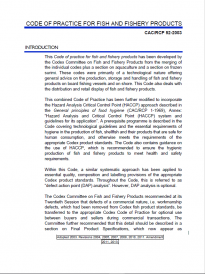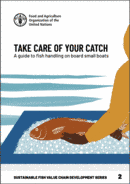Regulatory Environment for Handling After Harvest
The Codex Alimentarius Code of Practice for Fish and Fishery Products is a reference point for good practice that often becomes the basis of standards and legal requirements. As well as guidance on general good handling and hygiene and the use of Hazard Analysis and Critical Control Points (HACCP), the Code includes this in relation to harvesting and handling:
- When aquaculture products and molluscan shellfish are harvested using seines, nets or other means and are transported live to facilities:
- Seines, nets and traps should be carefully selected to ensure minimum damage during harvesting.
- Harvesting areas and all equipment for harvesting, catching, sorting, grading, conveying and transporting of live products should be designed for their rapid and efficient handling without causing mechanical damage. These should be easily cleanable and free from contamination.
- Conveying equipment for live and slaughtered products should be constructed of suitable corrosion-resistant material that does not transmit toxic substances and should not cause mechanical injuries to them.
- Where fish is transported live, care should be taken to avoid overcrowding and to minimize bruising.
- Where fish are held or transported live, care should be taken to maintain factors that affect fish health (e.g. CO2, O2, temperature and nitrogenous wastes).
Recommendations for Avoiding Physical Damage
Recommendations for Avoiding Physical Damage
To avoid physical damage, physical/biochemical change owing to stress of live fish during harvesting, the Code recommends that:
- Appropriate harvesting techniques should be applied to minimize physical damage and stress.
- Live fish should not be subjected to extremes of heat or cold or sudden variations in temperature and salinity.
- Fish should be free from excessive mud and weed soon after being harvested by washing with clean seawater or freshwater under suitable pressure.
- Fish should be purged, where necessary, to reduce gut contents and pollution of fish during further processing.
- Harvesting should be rapid so that fish are not exposed unduly to high temperatures.
- All equipment and holding facilities should be easy to clean and to disinfect and should be cleaned and disinfected regularly and as appropriate.
Guidelines are also included on holding and transportation, storage and transportation of live fish, live fish stored and transported at ambient temperature and live fish stored and transported at low temperatures.
Food Safety Regulation
Food Safety Regulation
The European Union has one of the largest markets for fish in the world and producers involved in supplying this market, whether they are within the EU or outside it, are obliged to abide by two key pieces of food safety legislation that relate to harvesting and handling practices which promote a reduction in food loss and waste (FLW):
- Regulation (EC) No 853 / 2004 (Annex III) on specific hygiene rules for animal products
- Regulation (EC) No 852 / 2004 (Annex I) on the hygiene of foodstuffs
These regulations have been used to influence the national legislation in many countries, particularly those exporting fish to the EU market.
Certification
Certification
Certification is an important aspect of aquaculture production. Producers that wish to be certified to demonstrate good practice and improve market access - for example, under the Best Aquaculture Practice (BAP) program - need to demonstrate meeting standards related to harvesting, handling and transport which promote FLW control.
Key Publications
Code of Practice for Fish and Fishery Products CAC/RCP 52-2003 Global standard that presents information on freezing and cold storage practices which aim to reduce spoilage and waste. | |
Provides information on the level of polycyclic aromatic hydrocarbons (PAH) allowed in smoked fish entering the EU market. | |
European Union regulation that guides national requirements related to handling and hygiene. Annex III Section VIII specifically focuses on fish and fishery products. |
More Resources
More Resources
31 October 2023














